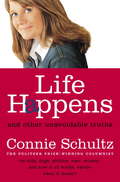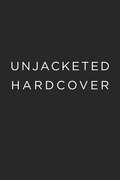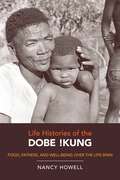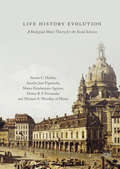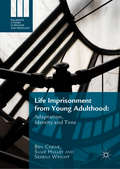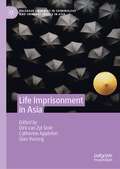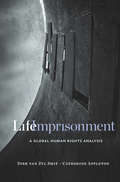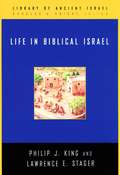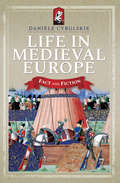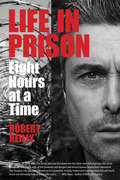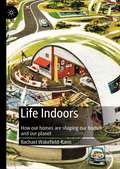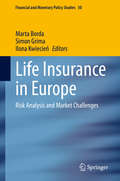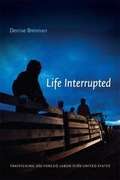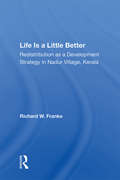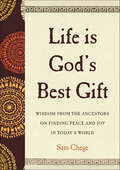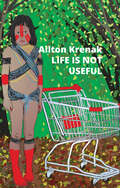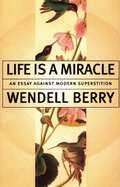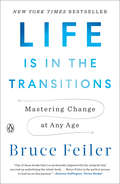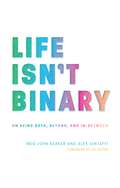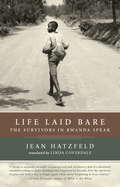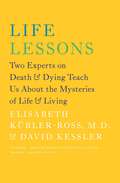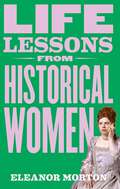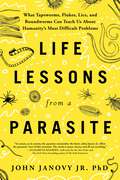- Table View
- List View
Life Happens
by Connie SchultzFrom the 2005 Pulitzer Prize—winning columnist Connie Schultz comes fresh, clever, insightful commentary on life today: love, politics, social issues, family, and much, much more. In the tradition of Anna Quindlen, Molly Ivins, and Erma Bombeck, but with a distinctive voice and sensibility all her own, Connie Schultz comes out of the heartland of America to get you seeing, feeling, and thinking more deeply about the lives we lead today. “You might spot someone you know in the stories here,” writes Connie. “Maybe you’ll even find a glimpse of yourself. Yes, each of us is unique, but life happens in ways that bind us like Gorilla Glue. ” In Life Happens, Connie shares sharp, passionate observations, winning our hearts with personal thoughts on a wide range of topics, from finding love in middle age to the meaning behind her father’s lunch pail, from single motherhood, to who really gets the tips you leave and why as the war in Iraq, race relations, gay marriage, and wwhy women don’t vote. In a more humorous vein, Connie shares her mother’s advice on men (“Don’t marry him until you see how he treats the waitress”) and warns men everywhere against using the dreaded f-word (it’s not the one you think). Along the way, Connie introduces us to the heroic people who populate our world and shows us how just one person can make a difference. Charming, provocative, funny, and perceptive, Life Happens gives us, for the first time, Connie Schultz’s celebrated commentary in one irresistible volume. Life Happens challenges us to be more open and alive to others and to the world around us.
Life Histories of the Dobe !Kung: Food, Fatness, and Well-Being over the Life-Span
by Nancy HowellLife Histories of the Dobe !Kung examines the health, food and nutrition of the Dobe !Kung, the well-known "Bushmen" of the Kalahari Desert.
Life Histories of the Dobe !Kung: Food, Fatness, and Well-being over the Life-span (Origins of Human Behavior and Culture #4)
by Nancy HowellLife Histories of the Dobe !Kung re-examines an important anthropological data set for the Dobe !Kung, the well-known "Bushmen" of the Kalahari Desert, collected by Nancy Howell and colleagues. Using life history analysis, Howell reinterprets this rich material to address the question of how these hunter-gatherers maintain their notably good health from childhood through old age in the Kalahari’s harsh environment. She divides the population into life history stages that correlate with estimated chronological ages and demonstrates how and why they survive, even thrive, on a modest allotment of calories. She describes how surplus food is produced and distributed, and she considers both the motives for the generous sharing she has observed among the Dobe !Kung and some evolutionary implications of that behavior.
Life History Evolution: A Biological Meta-Theory for the Social Sciences
by Steven C. Hertler Aurelio José Figueredo Mateo Peñaherrera-Aguirre Michael A. Woodley of Menie Heitor B. FernandesThe social sciences share a mission to shed light on human nature and society. However, there is no widely accepted meta-theory; no foundation from which variables can be linked, causally sequenced, or ultimately explained. This book advances “life history evolution” as the missing meta-theory for the social sciences. Originally a biological theory for the variation between species, research on life history evolution now encompasses psychological and sociological variation within the human species that has long been the stock and trade of social scientific study. The eighteen chapters of this book review six disciplines, eighteen authors, and eighty-two volumes published between 1734 and 2015—re-reading the texts in the light of life history evolution.
Life Imprisonment from Young Adulthood: Adaptation, Identity and Time (Palgrave Studies in Prisons and Penology)
by Ben Crewe Susie Hulley Serena WrightThis book analyses the experiences of prisoners in England & Wales sentenced when relatively young to very long life sentences (with minimum terms of fifteen years or more). Based on a major study, including almost 150 interviews with men and women at various sentence stages and over 300 surveys, it explores the ways in which long-term prisoners respond to their convictions, adapt to the various challenges that they encounter and re-construct their lives within and beyond the prison. Focussing on such matters as personal identity, relationships with family and friends, and the management of time, the book argues that long-term imprisonment entails a profound confrontation with the self. It provides detailed insight into how such prisoners deal with the everyday burdens of their situation, feelings of injustice, anger and shame, and the need to find some sense of hope, control and meaning in their lives. In doing so, it exposes the nature and consequences of the life-changing terms of imprisonment that have become increasingly common in recent years.
Life Imprisonment in Asia (Palgrave Advances in Criminology and Criminal Justice in Asia)
by Catherine Appleton Dirk van Zyl Smit Giao VucongLife imprisonment is the punishment most often imposed worldwide for what societies regard as the most serious offences. Yet, in Asia the phenomenon has never been studied systematically. Life Imprisonment in Asia fills this major gap. It brings together thirteen new essays on life imprisonment in key jurisdictions in the region. Each chapter consolidates what is known about the law and practice of life imprisonment in the jurisdiction and then explores aspects of the imposition or implementation of life sentences that the authors regard as particularly problematic. In some instances, the main issue is the imposition of life sentences by the courts and their relationship to the death penalty. In others, the focus is on the treatment of life sentenced prisoners. In many instances, the most prominent question is whether life sentenced prisoners should be released and, if so, according to what processes. In the overview chapter, the editors place the complex picture that emerges of life imprisonment in Asia in a global context and point to reforms urgently required to ensure that Asian life sentences meet international human rights standards.Life Imprisonment in Asia should be read by everyone who has an interest in just punishments for serious offences, not only in Asia, but throughout the world. It will be an invaluable tool for lawyers, criminologists, policy makers and penal reform advocates in the region and beyond.
Life Imprisonment: A Global Human Rights Analysis (Oñati International Series In Law And Society Ser.)
by Dirk van Zyl SmitLife imprisonment has replaced the death penalty as the most common sentence imposed for heinous crimes worldwide. Consequently, it has become the leading issue of international criminal justice reform. In the first survey of its kind, Dirk van Zyl Smit and Catherine Appleton argue for a human rights–based reappraisal of this harsh punishment.
Life In Biblical Israel
by Philip King Lawrence StagerThis special-edition volume of the Library of Ancient Israel, based on the latest research, presents a vivid description of the world of Ancient Israel, covering such topics as domestic life, the means of existence, cultural expression, and religious practices. With over 175 full-color pictures and illustrations,Life in Biblical Israelopens the door to everyday life in biblical Israel for all readers. This volume is perfect for classrooms, coffee tables, and personal use. <p><p> Volumes in the Library of Ancient Israel draw on multiple disciplines--such as archaeology, anthropology, sociology, linguistics, and literary criticism--to illuminate the everyday realities and social subtleties these ancient cultures experienced. This series employs sophisticated methods resulting in original contributions that depict the reality of the people behind the Hebrew Bible and interprets these insights for a wide variety of readers.
Life In Medieval Europe: Fact and Fiction
by Danièle Cybulskie&“A lovely, witty treasure trove of a book, spilling over with historical gems . . . a very human history: sometimes weird, always wonderful.&” —Dan Jones, New York Times-bestselling author Have you ever found yourself watching a show or reading a novel and wondering what life was really like in the Middle Ages? What did people actually eat? Were they really filthy? And did they ever get to marry for love? In Life in Medieval Europe: Fact and Fiction, you&’ll find fast and fun answers to all your secret questions, from eating and drinking to sex and love. Find out whether people bathed, what they did when they got sick, and what actually happened to people accused of crimes. Learn about medieval table manners, tournaments, and toothpaste, and find out if people really did poop in the moat. &“To say that this book was fun to read would be an understatement. Cybulskie&’s knowledge radiates in every page of this short book . . . It was educational and entertaining all at the same time. Simply a wonderful resource for novice medievalists and writers of historical fiction and nonfiction alike.&” —Adventures of a Tudor Nerd &“All in all, this is an excellent book to put to bed many of the myths surrounding medieval existence that persist in the popular imagination. Easy to read and well worth the time to read it. I highly recommend this book if you want to get a mostly unbiased view of medieval life.&” —Battles and Book Reviews
Life In Prison: Eight Hours at a Time
by Robert Reilly<P> In this gripping nonfiction account, Robert Reilly provides a look inside America’s prison system unlike any other, and the way that it affects not only the prisoners themselves but also the corrections officers and their families. <P> After 13 years of struggling in the music business, Robert Reilly found himself broke and on the edge of despair. The specter of success in the music business had become a monster about to ruin his family life. Something had to change, or something was going to break beyond repair. <P> A chance conversation with a neighbor led him to apply, somewhat half-heartedly, for a job at the county prison. Although he hated the thought of a “real job,” a regular salary of $40,000 with benefits, and paid time off seemed like a small fortune. “Amazingly, I somehow got hired. So, in an effort to do the right thing and put my family first, I left the madness of the music business and entered the insanity of the U.S. prison system.” <P> Robert Reilly served a seven-year term as a prison guard in Pennsylvania and Maine. Entering America’s industrial prison system in search of a way to support his young family, the struggling musician found himself in a looking-glass world where, often, only the uniforms distinguished guards from prisoners. Life in Prison chronicles the horrors of a place where justice is arbitrary, outcomes are preordained, and the private sector makes big money while the public looks away. This is Reilly’s story of doing time. <P> To call the experience sobering would be the ultimate understatement: “As time crawls by, I become jealous of the inmates leaving the prison. I start to slip; I start to feel like I’m losing my faith. Any trace of innocence that I thought I still had starts to evaporate. I begin to feel trapped, imprisoned, locked in a dark heartbreaking world, just like an inmate.” <b> *Silver Medal, 2015 IBPA Benjamin Franklin Awards, Best New Voice**Finalist, Memoir, 2015 Maine Literary Award* </b>
Life Indoors: How our homes are shaping our bodies and our planet
by Rachael Wakefield-RannIn this timely and expansive book, Wakefield-Rann investigates how emerging disease ecologies are undermining definitions of health and immunity that have persisted since the 19th century, and had a formative influence over the design of not only homes, but entire cities. This wide-ranging account traces the links between the history of medicine, modernist design and architecture, the rise of inflammatory disease, the microbiomes of buildings and humans, antimicrobial resistance, and novel chemical pollutants, to show how indoor environments have made us as we have made them. In highlighting the processes that have been missed in designing perfectly controlled interior habitats, Life Indoors shows the limitations of dominant practices, classifications and philosophies to apprehend current indoor pathogen ecologies.
Life Insurance in Europe: Risk Analysis and Market Challenges (Financial and Monetary Policy Studies #50)
by Simon Grima Marta Borda Ilona KwiecieńThis book examines the challenges for the life insurance sector in Europe arising from new technologies, socio-cultural and demographic trends, and the financial crisis. It presents theoretical and applied research in all areas related to life insurance products and markets, and explores future determinants of the insurance industry’s development by highlighting novel solutions in insurance supervision and trends in consumer protection. Drawing on their academic and practical expertise, the contributors identify problems relating to risk analysis and evaluation, demographic challenges, consumer protection, product distribution, mortality risk modeling, applications of life insurance in contemporary pension systems, financial stability and solvency of life insurers. They also examine the impact of population aging on life insurance markets and the role of digitalization. Lastly, based on an analysis of early experiences with the implementation of the Solvency II system, the book provides policy recommendations for the development of life insurance in Europe.
Life Interrupted: Trafficking into Forced Labor in the United States
by Denise BrennanLife Interrupted introduces us to survivors of human trafficking who are struggling to get by and make homes for themselves in the United States. Having spent nearly a decade following the lives of formerly trafficked men and women, Denise Brennan recounts in close detail their flight from their abusers and their courageous efforts to rebuild their lives. At once scholarly and accessible, her book links these firsthand accounts to global economic inequities and under-regulated and unprotected workplaces that routinely exploit migrant laborers in the United States. Brennan contends that today's punitive immigration policies undermine efforts to fight trafficking. While many believe trafficking happens only in the sex trade, Brennan shows that across low-wage labor sectors--in fields, in factories, and on construction sites--widespread exploitation can lead to and conceal forced labor. Life Interrupted is a riveting account of life in and after trafficking and a forceful call for meaningful immigration and labor reform.All royalties from this book will be donated to the nonprofit Survivor Leadership Training Fund administered through the Freedom Network.
Life Is A Little Better: Redistribution As A Development Strategy In Nadur Village, Kerala
by Richard W FrankeThis ethnography of Nadur Village explores the ramifications of Kerala State's policy of wealth redistribution to achieve equality. The author shows a decline in income inequality and an improved quality of life for most villagers despite high unemployment, low incomes and the persistence of inequalities that redistribution has not overcome. This e
Life Is God's Best Gift: Wisdom from the Ancestors on Finding Peace and Joy in Today's World
by Sam ChegeFollowing the success of the megabestselling Black Pearls, a collection of 365 African proverbs that illuminate the secret to peace and joy; and inspire the words of Cudjo Lewis in Zora Neale Hurston’s Barracoon.In Africa, grandparents traditionally share their wisdom about life and culture with their grandchildren, using proverbs and stories that have been passed down from generation to generation. This beautiful keepsake volume includes 365 proverbs—one for each day of the year—partnered with brief, yet profound lessons and knowledge covering all facets of life. Collected from countries across the African continent, these wise proverbs encourage children to treasure community over material items; show kindness to others; love from the heart and not the mind; exercise empathy; and strive for a global education. These thoughtful proverbs include insights such as:Proverb: “Love, like rain, does not choose the grass on which it falls.” (South Africa)Insight: True love is blind. True love is not based on wealth, family, position, education, tribe, religion or class. Love can bind together a most unlikely couple, as the heart has reasons that reason does not understand.Proverb: “When an old man dies, a library burns to the ground.” (Gambia)Insight: The elders of the community hold the wisdom of the world.Devoting a little time, day by day for a full year, this holistic, enriching gift book can lead to inner peace and happiness.
Life Is Not Useful
by Ailton KrenakIndigenous leader and activist Ailton Krenak reminds us that we must awaken from the comatose senselessness we have been immersed in since the beginning of the modern colonial project, where order, progress, development, consumerism, and capitalism have taken over our entire existence, leaving us only very partially alive, and, in fact, almost dead. To awaken from the coma of modernity is, for Krenak, to awaken to the possibility of becoming attuned to “the cosmic sense of life.” He points out that the COVID-19 pandemic affects all so-called “human” lives and that the time is ripe for us all to reflect on and undo the exclusivity and distinction that have characterized the concept of humanity throughout Western modernity.
Life Is a Miracle: An Essay Against Modern Superstition
by Wendell BerryActually consisting of a set of wide-ranging, sentimental essays in which farmer, poet and writer Wendell Berry argues for greater dialogue between the arts and sciences, attempts to show that E.O. Wilson's "Consilience" is no more than the subjugation of religion and art by science, and advocates a new "emancipation proclamation" to free people from enslavement by corporations.
Life Is in the Transitions: Mastering Change at Any Age
by Bruce FeilerA pioneering and timely study of how to navigate life's biggest transitions with meaning, purpose, and skillBruce Feiler, author of the New York Times bestsellers The Secrets of Happy Families and Council of Dads, has long explored the stories that give our lives meaning. Galvanized by a personal crisis, he spent the last few years crisscrossing the country, collecting hundreds of life stories in all fifty states from Americans who&’d been through major life changes—from losing jobs to losing loved ones; from changing careers to changing relationships; from getting sober to getting healthy to simply looking for a fresh start. He then spent a year coding these stories, identifying patterns and takeaways that can help all of us survive and thrive in times of change.What Feiler discovered was a world in which transitions are becoming more plentiful and mastering the skills to manage them is more urgent for all of us. The idea that we&’ll have one job, one relationship, one source of happiness is hopelessly outdated. We all feel unnerved by this upheaval. We&’re concerned that our lives are not what we expected, that we&’ve veered off course, living life out of order. But we&’re not alone.Life Is in the Transitions introduces the fresh, illuminating vision of the nonlinear life, in which each of us faces dozens of disruptors. One in ten of those becomes what Feiler calls a lifequake, a massive change that leads to a life transition. The average length of these transitions is five years. The upshot: We all spend half our lives in this unsettled state. You or someone you know is going through one now.The most exciting thing Feiler identified is a powerful new tool kit for navigating these pivotal times. Drawing on his extraordinary trove of insights, he lays out specific strategies each of us can use to reimagine and rebuild our lives, often stronger than before.From a master storyteller with an essential message, Life Is in the Transitions can move readers of any age to think deeply about times of change and how to transform them into periods of creativity and growth.
Life Isn't Binary: On Being Both, Beyond, and In-Between
by Alex Iantaffi Meg-John BarkerMuch of society's thinking operates in a highly rigid and binary manner; something is good or bad, right or wrong, a success or a failure, and so on. Challenging this limited way of thinking, this ground-breaking book looks at how non-binary methods of thought can be applied to all aspects of life, and offer new and greater ways of understanding ourselves and how we relate to others.Using bisexual and non-binary gender experiences as a starting point, this book addresses the key issues with binary thinking regarding our relationships, bodies, emotions, wellbeing and our sense of identity and sets out a range of practices which may help us to think in more non-binary, both/and, or uncertain ways.A truly original and insightful piece, this guide encourages reflection on how we view and understand the world we live in and how we all bend, blur or break society's binary codes.
Life Laid Bare
by Linda Coverdale Jean Hatzfeld"To make the effort to understand what happened in Rwanda is a painful task that we have no right to shirk-it is part of being a moral adult."-Susan SontagIn the late 1990s, French author and journalist Jean Hatzfeld made several journeys into the hilly, marshy region of the Bugesera, one of the areas most devastated by the Rwandan genocide of April 1994, where an average of five out of six Tutsis were hacked to death with machete and spear by their Hutu neighbors and militiamen. In the villages of Nyamata and N'tarama, Hatzfeld interviewed fourteen survivors of the genocide, from orphan teenage farmers to the local social worker. For years the survivors had lived in a muteness as enigmatic as the silence of those who survived the Nazi concentration camps. In Life Laid Bare, they speak for those who are no longer alive to speak for themselves; they tell of the deaths of family and friends in the churches and marshes to which they fled, and they attempt to account for the reasons behind the Tutsi extermination. For many of the survivors "life has broken down," while for others, it has "stopped," and still others say that it "absolutely must go on."These horrific accounts of life at the very edge contrast with Hatzfeld's own sensitive and vivid descriptions of Rwanda's villages and countryside in peacetime. These voices of courage and resilience exemplify the indomitable human spirit, and they remind us of our own moral responsibility to bear witness to these atrocities and to never forget what can come to pass again. Winner of the Prix France Culture and the Prix Pierre Mille, Life Laid Bare allows us, in the author's own words, "to draw as close as we can get to the Rwandan genocide."
Life Lessons
by David Kessler Elisabeth Kübler-RossIs this really how I want to live my life?Each one of us at some point asks this question. The tragedy is not that life is short but that we often see only in hindsight what really matters.In this, her first book on life and living, Elisabeth Kubler-Ross joins with David Kessler to guide us through the practical and spiritual lessons we need to learn so that we can live life to its fullest in every moment. Many years of working with the dying have shown the authors that certain lessons come up over and over again. Some of these lessons are enormously difficult to master, but even the attempts to understand them can be deeply rewarding. Here, in fourteen accessible chapters, from the Lesson of Love to the Lesson of Happiness, the authors reveal the truth about our fears, our hopes, our relationships, and, above all, about the grandness of who we really are.
Life Lessons From Historical Women
by Eleanor MortonTake a tour of the past and uncover stories of the women whose lives and achievements have shaped our modern world. In Life Lessons from Historical Women, Eleanor Morton celebrates the ordinary women whose decisions and accomplishments in their everyday lives resonate with us today.Taking inspiration from the thriving self-help genre, Morton reasons that the greatest lessons can be taken from the female forebears who have come before - women whose actions inspire purpose, creativity and rebellion... without a side of pseudo psychology and judgement...Covering the full gamut of the female experience, and women from all corners of history and the globe, Life Lessons from Historical Women includes chapters on 'How To Thrive' with Judith Kerr, 'Think Like an Entrepreneur' with Mary Seacole, and 'How Not to Give a Fuck' with the famous suffragette martyr Emily Davison.Whether it's what we can learn from the first woman to summit Everest or the trailblazing ladies who confirm that pockets have always been must-have in women's clothing, Eleanor writes with humour and a sincere respect for our history, and imparts valuable lessons for the modern female.
Life Lessons From Historical Women
by Eleanor MortonTake a tour of the past and uncover stories of the women whose lives and achievements have shaped our modern world. In Life Lessons from Historical Women, Eleanor Morton celebrates the ordinary women whose decisions and accomplishments in their everyday lives resonate with us today.Taking inspiration from the thriving self-help genre, Morton reasons that the greatest lessons can be taken from the female forebears who have come before - women whose actions inspire purpose, creativity and rebellion... without a side of pseudo psychology and judgement...Covering the full gamut of the female experience, and women from all corners of history and the globe, Life Lessons from Historical Women includes chapters on 'How To Thrive' with Judith Kerr, 'Think Like an Entrepreneur' with Mary Seacole, and 'How Not to Give a Fuck' with the famous suffragette martyr Emily Davison.Whether it's what we can learn from the first woman to summit Everest or the trailblazing ladies who confirm that pockets have always been must-have in women's clothing, Eleanor writes with humour and a sincere respect for our history, and imparts valuable lessons for the modern female.
Life Lessons From Historical Women
by Eleanor MortonTake a tour of the past and uncover stories of the women whose lives and achievements have shaped our modern world. In Life Lessons from Historical Women, Eleanor Morton celebrates the ordinary women whose decisions and accomplishments in their everyday lives resonate with us today.Taking inspiration from the thriving self-help genre, Morton reasons that the greatest lessons can be taken from the female forebears who have come before - women whose actions inspire purpose, creativity and rebellion... without a side of pseudo psychology and judgement...Covering the full gamut of the female experience, and women from all corners of history and the globe, Life Lessons from Historical Women includes chapters on 'How To Thrive' with Judith Kerr, 'Think Like an Entrepreneur' with Mary Seacole, and 'How Not to Give a Fuck' with the famous suffragette martyr Emily Davison.Whether it's what we can learn from the first woman to summit Everest or the trailblazing ladies who confirm that pockets have always been must-have in women's clothing, Eleanor writes with humour and a sincere respect for our history, and imparts valuable lessons for the modern female.
Life Lessons from a Parasite: What Tapeworms, Flukes, Lice, and Roundworms Can Teach Us About Humanity's Most Difficult Problems
by John Janovy Jr. PhD"In nature, as in society, the parasites outnumber the hosts. John Janovy Jr. offers the parasites' view of this situation. The result is smart, funny, and all too revealing." – Elizabeth Kolbert, staff writer for The New Yorker and New York Times bestselling author of The Sixth ExtinctionThe answers to life's biggest questions can be found by looking at the little things… Though you may not be able to see them with the naked eye, parasites—miniscule life forms that live inside other organisms—inhabit our everyday lives. From headlice to bird droppings, litterboxes to unfiltered water, you have brushed up against the most common way of life on our planet.In this unique book, John Janovy Jr., one of the world's preeminent experts on parasites, reveals what can humans learn from the most reviled yet misunderstood animals on Earth: lice, tapeworms, flukes, and maggots that can eat a lizard from the inside, and how these lessons help us negotiate our own complicated world. Whether we're learning to adapt to adverse conditions, accept our own limitations, or process new information in an ever-changing landscape—we can be sure a parasite did it first. At once peculiar and profound, Life Lessons from a Parasite makes a case for using knowledge of the natural world, with all its wonderful mysteries and quirks, to tackle our worst problems.
